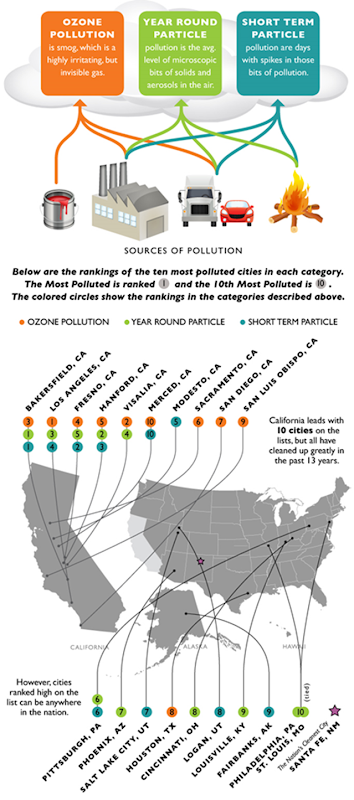American Lung Association: 41 percent of Americans live in counties with unhealthful levels of ozone or particle pollution
Thanks to the Clean Air Act, we’ve made great progress in cleaning up air pollution from across the U.S. The State of the Air 2012 shows that the air quality in many places has improved, but that over 127 million people—41 percent of the nation—still suffer pollution levels that are too often dangerous to breathe. Unhealthy air remains a threat to the lives and health of millions of people in the United States, despite great progress. Air pollution lingers as a widespread and dangerous reality even as some seek to weaken the Clean Air Act, the public health law that has driven the cuts in pollution since 1970.
- More than 4 in 10 people (41%) in the United States live in counties that have unhealthful levels of either ozone or particle pollution. Over 127.2 million Americans live in the 235 counties where they are exposed to unhealthful levels of air pollution in the form of either ozone or short-term or year-round levels of particles.
- Over 5.7 million people (1.9%) in the United States live in six counties with unhealthful levels of all three: ozone and short-term and year-round particle pollution: ozone and short-term and year-round particle pollution.
- The strongest improvement came in reducing ozone smog levels across the nation. More than half of the country’s most-smog-polluted cities experienced their best year yet. Twenty two of the 25 cities with the most ozone pollution improved their air quality over the past year’s report. More than half of the country’s most smog-polluted cities experienced their best year yet. Still, nearly four in ten people in the U.S. (37.8%) live in areas with unhealthful levels of ozone pollution.
- All but two cities with the most year-round particle pollution (sometimes called soot) improved over the previous report. Seventeen of those cities reported their best-ever particle pollution levels.
- Success in reducing short-term particle pollution levels varied among metro areas. Thirteen of the most polluted cities saw improvement compared to last year’s report, while twelve had worse problems with these spikes in particle levels.
The State of the Air 2012 report looks at levels of ozone and particle pollution found in official monitoring sites across the United States in 2008, 2009, and 2010. The report uses the most current quality-assured nationwide data available for these analyses. For particle pollution, the report examines fine particulate matter (PM2.5) in two different ways: averaged year-round (annual average) and over short-term levels (24-hour). For both ozone and short-term particle pollution, the analysis uses a weighted average number of days that allows recognition of places with higher levels of pollution. For the year-round particle pollution rankings, the report uses averages calculated and reported by the U.S. Environmental Protection Agency. For comparison, the State of the Air 2011 report covered data from 2007, 2008, and 2009.
